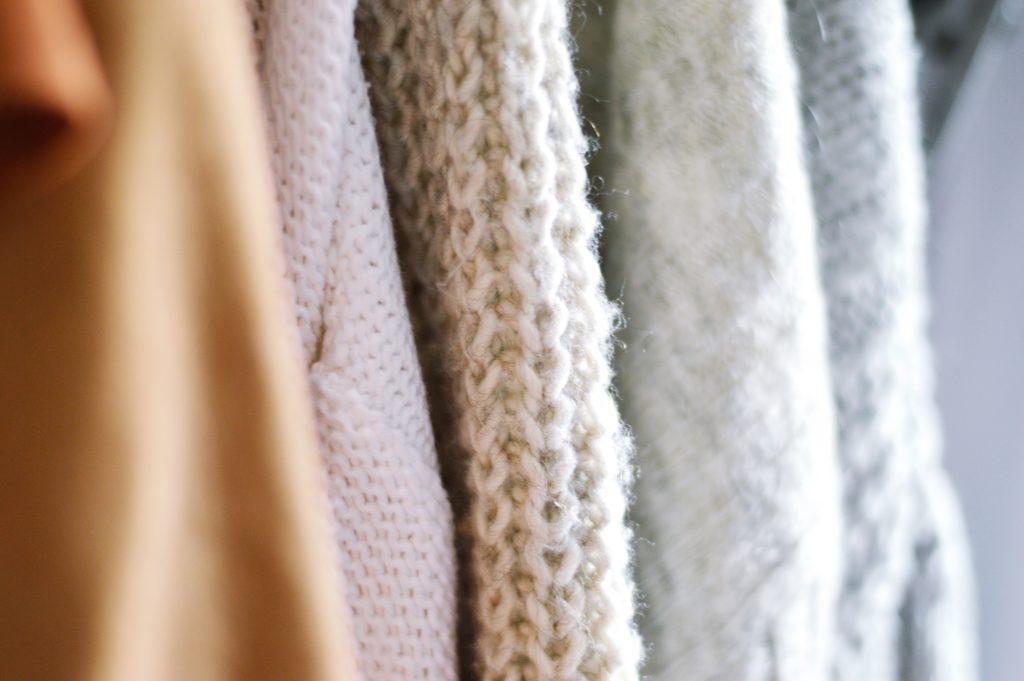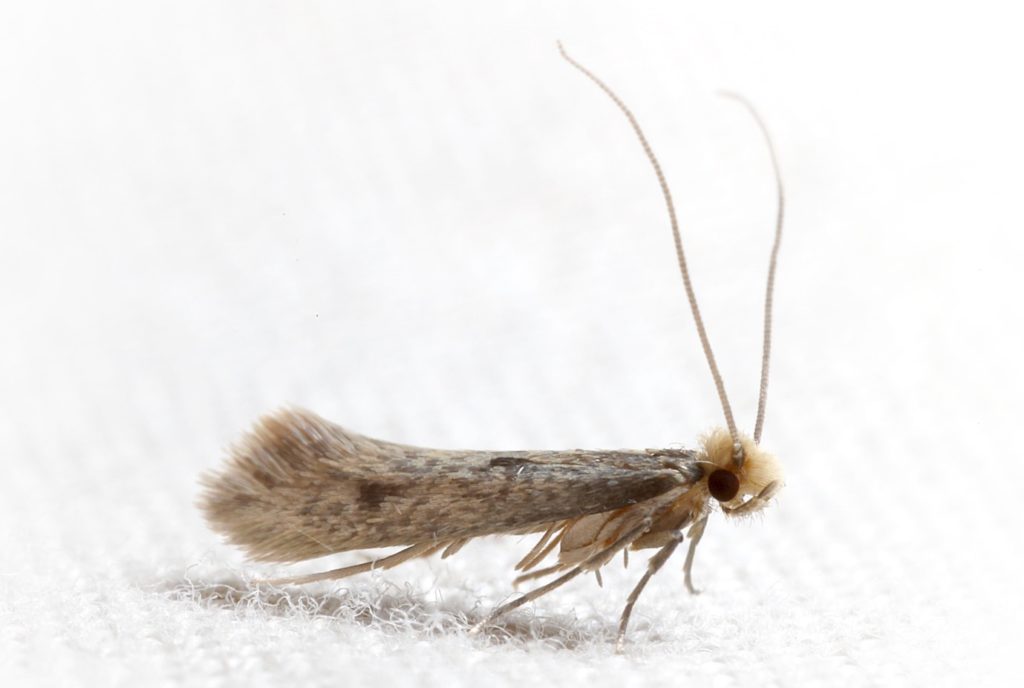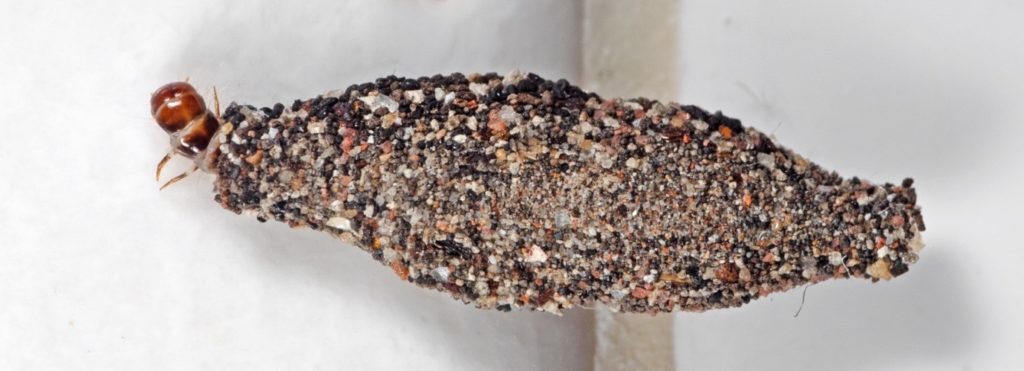Clothes moths are tiny moths that produce larvae which feed on our natural fibre clothes and furnishings. It may seem strange that “clothes moths” are from a family of moths known as “fungus moths”. However, in the wild, many of the moth species in this family have larvae that feed on fungi, lichens and dead organic material. Other related species can be found feeding on feathers in bird nests, the remains of owl pellets (undigested bones and feathers regurgitated by owls) or hair in rodent nests. (Photo by iStock.com/Heather Broccard-Bell)
The main pest species that are found in our homes are the case-making clothes moth Tinea pellionella, and the webbing clothes moth Tineola bisselliella. These species thrive in conditions created by humans and have been introduced to all continents, including Australia, through the transport of textiles. The webbing clothes moth is thought to have originated in Africa and was apparently accidentally introduced into Europe with the trade of natural products and game trophies from Africa during the 19th century [1].
A long and secretive lifecycle
The clothes moth’s lifecycle includes eggs, larvae, pupae and the adult moth, but you may never see any of them. Why? The eggs are miniscule, the larvae feed on clothing that have been put away for storage and the adults are short lived and prefer dark, quiet spaces.
Female clothes moths only live for a few weeks and lay 50 – 100 eggs in that time [2]. The tiny eggs, deposited into any clothing or household furnishings made of natural fibres, usually hatch within one to two weeks when conditions are warm enough (summer or in well heated rooms). [3]
Hatched larvae start feeding immediately, and then begin to spin silk. The case-making moth larvae create a permanent silken case that they carry with them as they move around.
The webbing clothes moth larvae create temporary silken feeding tubes which they can retreat into, and when they move around, they simply create additional tubes. Larvae can survive feeding on clothes, carpets or furnishings for up to three years, depending on temperatures, and in this time, they can do a lot of damage! As we tend to keep our houses warm and comfortable throughout the year however, often the larvae can complete their feeding stage in six months or less, before finding a secluded spot to spin a cocoon and pupate.
After a short period as pupae, the adult moths emerge and quickly find a mate. The females lay their eggs and the cycle starts again. The moths themselves do not feed and do not cause the damage, however, if you do see them fluttering around your wardrobe, you can be fairly sure they have just laid eggs somewhere nearby. This would be a good time to spring clean the wardrobe to remove any eggs and larvae before they do the damage.
There may be two, or sometimes three, generations of moths in a year, but the flying stage is relatively short-lived and tends to be secretive, preferring undisturbed areas and low light, which is why you may not see them.
How can we manage clothes moths?
Clothes storage
Apart from feeding on the clothing fibres themselves, the moth larvae will also make a meal of any sweat or food remains left behind on clothes. A study of case-bearing moths [4] found that woollen materials impregnated with yeast were more suited to larval development than those not treated. It is very important therefore to ensure clothes are clean and dry before they are stored for any extended length of time.
Similarly, constant darkness and high humidity increase the feeding activity and amount of damage done by the larvae, so placing stored clothes in areas that are still in use and subject to occasional light and ventilation via doors being opened can help deter infestations.
Preventatives
The value of cedar as a repellent has been of interest since colonists found red cedar in abundance on the east coast of USA. It was believed that cedar dust and shavings protected woollen clothing from moths and the red cedar wood was considered ideal for making cabinets and boxes for storing woollens due to the odour being repellent to insects. [5]. The placement of cedarwood balls or rings in the wardrobe, or within storage bags containing clothes to be stored for extended periods, may help deter egg laying female moths and keep clothes fresh due to the moisture absorbing, bacteria fighting properties of the wood.
Monitoring
Trapping is the simplest method for monitoring clothes moth. Pheromone traps emit tiny amounts of a chemical which strongly attracts males of the clothes moth species. The moths are attracted to the trap and become stuck to the internal sticky surface. The traps should be placed in closets and clothes storage areas and checked regularly. They enable the detection of the presence of clothes moths and may also provide a degree of control, because the trapped males cannot mate [2].
Disinfestation
If a clothes moth infestation is discovered in the monitoring traps, it is necessary to check clothes carefully for signs of larval damage such as holes and larval casings. Any badly affected clothing should be disposed of. Other clothing should be removed and laundered (dry cleaned or hot washed). Wardrobe shelf surfaces should be wiped down with hot soapy water to removed eggs which will be very difficult to see. Floors, carpets, air-conditioning vents, underneath furniture and inside closets should be vacuumed to remove pupal stages and accumulated lint that may serve as a food source for larvae.
Bibliography
| [1] | R. Plarre and B. Krüger-Carstensen, “An attempt to reconstruct the natural and cultural history of the webbing clothes moth Tineola bisselliella hummel (Lepidoptera: Tineidae),” Journal of Entomological and Acarological Research, vol. 43, no. 2, pp. 83-93, 2011. |
| [2] | D. H. Choe, “Clothes moths,” [Online]. Available: http://www.ipm.ucdavis.edu/PMG/PESTNOTES/pn7435.html. [Accessed 18 2 2021]. |
| [3] | C. Klass, Clothes Moths, Ithaca, NY: Cornell University, 2006. |
| [4] | P. Cheema, “Studies on the Bionomics of the Case-bearing moth, Tinea pellionella (L.),” Bulletin of Entomological Research, vol. 47, no. 1, pp. 167-182, 1956. |
| [5] | H. B. Huddle and A. P. Mills, “The Toxicity of Cedar Oil Vapor to Clothes Moths,” Journal of Economic Entomology, vol. 45, no. 1, pp. 40-43, 1952. |



